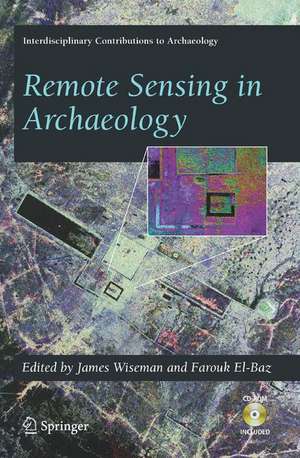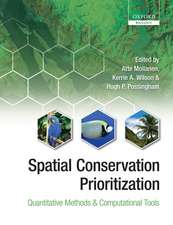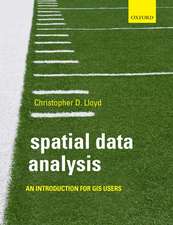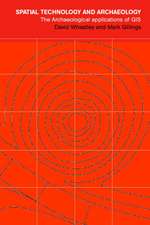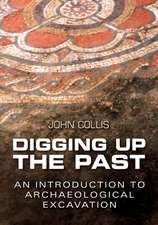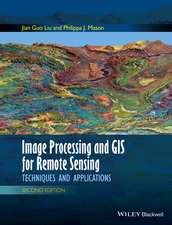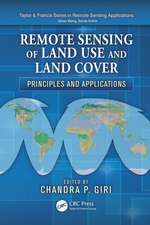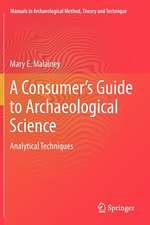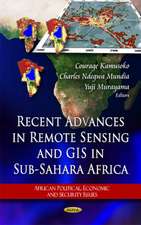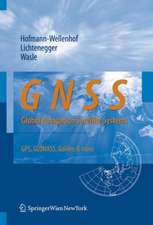Remote Sensing in Archaeology: Interdisciplinary Contributions to Archaeology
Editat de James R. Wiseman, Farouk El-Bazen Limba Engleză Paperback – 20 noi 2007
| Toate formatele și edițiile | Preț | Express |
|---|---|---|
| Paperback (1) | 1230.66 lei 6-8 săpt. | |
| Springer – 20 noi 2007 | 1230.66 lei 6-8 săpt. | |
| Hardback (1) | 1234.94 lei 6-8 săpt. | |
| Springer – 3 apr 2007 | 1234.94 lei 6-8 săpt. |
Din seria Interdisciplinary Contributions to Archaeology
- 24%
 Preț: 805.82 lei
Preț: 805.82 lei - 20%
 Preț: 817.75 lei
Preț: 817.75 lei - 15%
 Preț: 644.95 lei
Preț: 644.95 lei - 20%
 Preț: 630.27 lei
Preț: 630.27 lei - 15%
 Preț: 646.94 lei
Preț: 646.94 lei - 18%
 Preț: 962.49 lei
Preț: 962.49 lei - 15%
 Preț: 649.54 lei
Preț: 649.54 lei - 15%
 Preț: 583.43 lei
Preț: 583.43 lei - 15%
 Preț: 646.94 lei
Preț: 646.94 lei - 18%
 Preț: 960.61 lei
Preț: 960.61 lei - 15%
 Preț: 584.90 lei
Preț: 584.90 lei - 15%
 Preț: 518.92 lei
Preț: 518.92 lei -
 Preț: 404.13 lei
Preț: 404.13 lei - 15%
 Preț: 646.62 lei
Preț: 646.62 lei - 18%
 Preț: 948.27 lei
Preț: 948.27 lei - 15%
 Preț: 650.04 lei
Preț: 650.04 lei - 15%
 Preț: 645.60 lei
Preț: 645.60 lei - 18%
 Preț: 778.42 lei
Preț: 778.42 lei - 18%
 Preț: 1118.62 lei
Preț: 1118.62 lei - 18%
 Preț: 945.13 lei
Preț: 945.13 lei - 18%
 Preț: 1121.76 lei
Preț: 1121.76 lei - 18%
 Preț: 957.44 lei
Preț: 957.44 lei - 15%
 Preț: 644.95 lei
Preț: 644.95 lei - 15%
 Preț: 648.89 lei
Preț: 648.89 lei - 18%
 Preț: 949.55 lei
Preț: 949.55 lei - 18%
 Preț: 946.39 lei
Preț: 946.39 lei - 18%
 Preț: 967.40 lei
Preț: 967.40 lei - 18%
 Preț: 950.33 lei
Preț: 950.33 lei - 15%
 Preț: 641.38 lei
Preț: 641.38 lei - 18%
 Preț: 1232.71 lei
Preț: 1232.71 lei - 15%
 Preț: 648.24 lei
Preț: 648.24 lei - 15%
 Preț: 644.82 lei
Preț: 644.82 lei - 18%
 Preț: 2127.22 lei
Preț: 2127.22 lei - 18%
 Preț: 957.62 lei
Preț: 957.62 lei - 15%
 Preț: 586.37 lei
Preț: 586.37 lei - 18%
 Preț: 1422.77 lei
Preț: 1422.77 lei - 18%
 Preț: 962.35 lei
Preț: 962.35 lei - 18%
 Preț: 1231.16 lei
Preț: 1231.16 lei - 15%
 Preț: 641.71 lei
Preț: 641.71 lei - 15%
 Preț: 649.06 lei
Preț: 649.06 lei - 18%
 Preț: 952.40 lei
Preț: 952.40 lei - 15%
 Preț: 645.96 lei
Preț: 645.96 lei
Preț: 1230.66 lei
Preț vechi: 1500.81 lei
-18% Nou
Puncte Express: 1846
Preț estimativ în valută:
235.52€ • 244.97$ • 194.43£
235.52€ • 244.97$ • 194.43£
Carte tipărită la comandă
Livrare economică 14-28 aprilie
Preluare comenzi: 021 569.72.76
Specificații
ISBN-13: 9780387446158
ISBN-10: 038744615X
Pagini: 553
Ilustrații: XV, 554 p. 129 illus. With online files/update.
Dimensiuni: 155 x 235 x 28 mm
Greutate: 0.82 kg
Ediția:2007
Editura: Springer
Colecția Springer
Seria Interdisciplinary Contributions to Archaeology
Locul publicării:New York, NY, United States
ISBN-10: 038744615X
Pagini: 553
Ilustrații: XV, 554 p. 129 illus. With online files/update.
Dimensiuni: 155 x 235 x 28 mm
Greutate: 0.82 kg
Ediția:2007
Editura: Springer
Colecția Springer
Seria Interdisciplinary Contributions to Archaeology
Locul publicării:New York, NY, United States
Public țintă
ResearchCuprins
Radar And Satellite Images.- Imaging Radar in Archaeological Investigations: An Image Processing Perspective.- Radar Images and Geoarchaeology of the Eastern Sahara.- Southern Arabian Desert Trade Routes, Frankincense, Myrrh, and the Ubar Legend.- The Use of Interferometric Synthetic Aperture Radar (InSAR) in Archaeological Investigations and Cultural Heritage Preservation.- Detection and Identification of Archaeological Sites and Features Using Synthetic Aperture Radar (SAR) Data Collected from Airborne Platforms.- Putting Us on the Map: Remote Sensing Investigation of the Ancient Maya Landscape.- Creating and Perpetuating Social Memory Across the Ancient Costa Rican Landscape.- Spaceborne and Airborne Radar at Angkor: Introducing New Technology to the Ancient Site.- Aerial Photography and Fractals.- Remote Sensing, Fractals, and Cultural Landscapes: An Ethnographic Prolegomenon Using U2 Imagery.- Geographic Information Systems.- Understanding Archaeological Landscapes: Steps Towards an Improved Integration of Survey Methods in the Reconstruction of Subsurface Sites in South Tuscany.- Remote Sensing and GIS Analysis of a Maya City and Its Landscape: Holmul, Guatemala.- Remote Sensing and GIS Use in the Archaeological Analysis of the Central Mesopotamian Plain.- Geophysical Prospecting and Analytical Presentations.- Ground-penetrating Radar for Archaeological Mapping.- Integrating Multiple Geophysical Datasets.- Ground Penetrating Radar Advances in Subsurface Imaging for Archaeology.- Landscape Archaeology and Remote Sensing of a Spanish-Conquest Town: Ciudad Vieja, El Salvador.- Urban Structure at Tiwanaku: Geophysical Investigations in the Andean Altiplano.- Geophysical Archaeology in the Lower Amazon: A Research Strategy.- Maritime Setting Applications.- Archaeological Oceanography.- Precision Navigation and Remotes Sensing for Underwaters Archaeology.- Cultural Resources and Heritage Management.- Applications of Remote Sensing to the Understanding and Management of Cultural Heritage Sites.
Textul de pe ultima copertă
Whether deployed in space or on the surface of the earth, remote sensing instruments are increasingly becoming standard archaeological tools. Space age techniques have begun to accumulate a wealth of information and unusual evidence such as the presence of sand-buried courses of ancient rivers in the Sahara and the associated remains of human occupations. Perhaps as important, some have been able to gather priceless knowledge without disturbing fragile sites—a capability that is particularly significant in this era of conservation.
Remote Sensing in Archaeology illustrates the uses of advanced technology in archaeological investigation. It deals with hand-held instruments that probe the subsurface of the earth to unveil layering and associated sites; underwater exploration and photography of submerged sites and artifacts; and the utilization of imaging from aircraft and spacecraft to reveal the regional setting of archaeological sites and to assist in cultural resource management. In each case, the technical developments are explained first, followed by examples of applications as case studies.
Contributors are renowned experts from the international scientific community. Each chapter is composed as a self-standing contribution with a summary and an introduction to help the reader grasp the value of its contents. The book is profusely illustrated with graphs and photographs to explain the methodologies and results, so that the reader may better understand the principles involved and apply the knowledge gained to similar environments. Complete lists of references cited will also allow the reader to investigate more deeply the problems and findings.
"This book provides an excellent and diverse overview of the emerging capability of remote sensing archaeology and is a very valuable and important text for archaeologists in their quest to use advanced technology to help in their studies of exploration, and for remotesensing technologists and scientists by giving them a good understanding of the challenges that archaeologists find in their endeavors. The editors are to be applauded for bringing together such an excellent collection of authors and articles to cover this important emerging field."
—Charles Elachi, Director, Jet Propulsion Laboratory (NASA), Pasadena, California
Remote Sensing in Archaeology illustrates the uses of advanced technology in archaeological investigation. It deals with hand-held instruments that probe the subsurface of the earth to unveil layering and associated sites; underwater exploration and photography of submerged sites and artifacts; and the utilization of imaging from aircraft and spacecraft to reveal the regional setting of archaeological sites and to assist in cultural resource management. In each case, the technical developments are explained first, followed by examples of applications as case studies.
Contributors are renowned experts from the international scientific community. Each chapter is composed as a self-standing contribution with a summary and an introduction to help the reader grasp the value of its contents. The book is profusely illustrated with graphs and photographs to explain the methodologies and results, so that the reader may better understand the principles involved and apply the knowledge gained to similar environments. Complete lists of references cited will also allow the reader to investigate more deeply the problems and findings.
"This book provides an excellent and diverse overview of the emerging capability of remote sensing archaeology and is a very valuable and important text for archaeologists in their quest to use advanced technology to help in their studies of exploration, and for remotesensing technologists and scientists by giving them a good understanding of the challenges that archaeologists find in their endeavors. The editors are to be applauded for bringing together such an excellent collection of authors and articles to cover this important emerging field."
—Charles Elachi, Director, Jet Propulsion Laboratory (NASA), Pasadena, California
Caracteristici
Covers the breadth of remote sensing that is applicable to archaeology including satellite images, GIS, ground-penetrating radar, and maritime settings The cases included are international and covers sensing in arid, semi-arid and tropical regions
